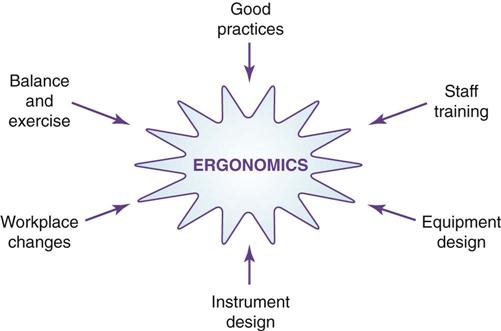Ergonomics
Learning Outcomes
On completion of this chapter, the student will be able to achieve the following objectives:
• Pronounce, define, and spell the Key Terms.
• Describe the goal of ergonomics.
• Demonstrate the exercises that can reduce muscle fatigue and strengthen muscles.
• Demonstrate the neutral working position.
• Demonstrate exercises to reduce eyestrain.
• Demonstrate exercises to reduce neck strain.
• Identify common symptoms of musculoskeletal disorders.
• Identify three categories of risk factors that contribute to increased risk for injury.
Electronic Resources
![]() Additional information related to content in Chapter 25 can be found on the companion Evolve Web site.
Additional information related to content in Chapter 25 can be found on the companion Evolve Web site.
![]() and the Multimedia Procedures DVD
and the Multimedia Procedures DVD
Key Terms
Carpal tunnel syndrome (CTS) Pain associated with continued flexion and extension of the wrist.
Cumulative (KYU-myeh-luh-tiv) trauma disorders (CTDs) Painful conditions that result from ongoing stresses to muscles, tendons, nerves, and joints.
Ergonomics (er-guh-NAH-miks) Adaptation of work environment and tasks to the human body.
Maximum horizontal reach Reach created when the upper arm is fully extended.
Maximum vertical reach Reach created by a vertical sweep of the forearm while the elbow is kept at midtorso level.
Musculoskeletal (mus-kyu-loh-SKEH-leh-tul) disorders (MSDs) Painful conditions that affect both muscles and bones, such as neck or back pain and carpal tunnel syndrome.
Neutral position Position when the body is properly aligned and the distribution of weight throughout the spine is equal.
Normal horizontal reach Reach created by a sweep of the forearm with the upper arm held at the side.
Sprains Injuries caused by sudden twisting or wrenching of a joint with stretching or tearing of ligaments.
Strains Injuries caused by extreme stretching of muscles or ligaments.
Thenar eminence (THEE-nar EH-meh-nents) Fleshy mound on the palm at the base of the thumb.
Many dental assistants have had to give up the career they love because of acute pain. Dental assistants often suffer with ongoing headaches, pain in the neck and shoulders, or numbness and tingling in the hands and wrists. Too often, when the dental assistant finally seeks help, the pain is severe and structural damage may be irreversible. You do not have to accept these hazards as part of your job. The key to preventing injury is to recognize and address the causes.
Ergonomics (from the Greek ergon, meaning “work,” and nomos, meaning “law”) deals with adaptation of the work environment to the human body. The goal of ergonomics is to help people stay healthy while performing their work more effectively. This can be done by changing workplace design, modifying instruments, strengthening muscles, taking breaks, using certain products, and providing proper training (Fig. 25-1).

This chapter discusses common risk factors for musculoskeletal disorders (MSDs), their symptoms, and techniques you can use to protect yourself from such injuries.
Ergonomics in the Dental Office
Ergonomics designs the work area and the task around the human body, rather than requiring the human to adapt to poorly designed equipment and working environments. Members of the dental team most frequently perform their work in a seated position, and they often use excessive motion and have unbalanced posture (Fig. 25-2). Many dental professionals experience pain associated with MSDs. Work-related symptoms range from back and joint pain to neck and shoulder pain, hand and wrist pain, and headaches.
Stay updated, free dental videos. Join our Telegram channel

VIDEdental - Online dental courses


